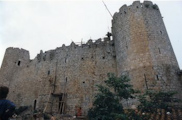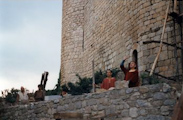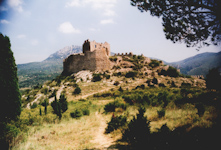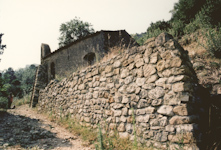Through the Corbières and the Cathar country
The Corbières massif with its gentle slopes from the Pyrénées and its narrow twisting roads is dominated by the fragrant scrubland of the garrigue. It offers a great diversity of landscapes - from the salt water lagoons of Bages, Gruissan, Sigean and Leucate, the fine sandy beaches of Narbonne- Plage and Gruissan to the vertiginous castle ruins of Peyrepertuse and Quéribus perched on rocky peaks which have been refuges to the Cathars escaping the Inquisition during the Albigensian crusades.
The Cathar country boasts the most evocative medieval citadel and architectural complex in Languedoc: Carcassonne. The walled city of Carcassonne with its famous Roman and medieval fortifications, its double ring of ramparts and 53 towers, is a World Heritage Site of the UNESCO since 1997.
It is also rich in early Romanesque chapels from the 9th century on (St Siméon in Boutenac, Montbrun), monasteries and abbeys like those of Fontfroide (Cistercian) and Lagrasse, St Hilaire (6th century) and St-Polycarpe (Benedictine abbey founded at the end of the 8th century).
The Canal du Midi is another Unesco World Heritage site; it has been built over 14 years (1667-1681) on the initiative of Pierre-Paul Riquet and links the Mediterranean sea with the Atlantic ocean over 240 km. Lined with big plane trees, poplars and pine trees which add to the charm of the many locks and bridges, it is most appreciated for the multitude of its hiking and cycling possibilities.
Besides Narbonne which was the Roman capital of the province Gallia Narbonensis, two archaelogical sites are of particular interest. The Roman potters' museum Amphoralis in Sallèles d'Aude on the site of the excavations of a potters' village (dating 1th BC) exhibits a huge group of workshops for producing amphorae (for wine and olive oil transport) and daily use ceramic ware. It shows a reconstructed kiln as well as the different producing and firing techniques used in Gallo-Roman times. The oppidum of Ensérune which has been an important settlement from the 6th BC situated close to the Via Domitia displays in its museum a rich collection of daily life and funerary objects.
Nature lovers will enjoy the great variety of walking and cycling tours. There is very little traffic on the backroads of this uncrowded region where the average density of the population lies around 35. Bikers can for example choose among the most different tours like along the Canal de la Robine starting from Narbonne to Port-la-Nouvelle or along the coastal route between Gruissan and Fleury d'Aude. The most experienced ones will prefer off-road tours through the Fontfroide massif. Birdwatchers will not rarely be able to spot flamingoes (especially near Bages), egrets, gulls and buzzards - a few Bonelli's eagles are even still nesting in the Clape massif.
For those interested in culinary traditions, the Corbières region is extremely rich in local products ranging from rosemary and thyme honey already used in Roman times, the Lucques olive with its typical elongated shape and crispy pulp, goat and sheep cheeses to oysters, mussels including the wide range of fresh fish caught in the Mediterranean (tuna, sardines, red mullet, bream, sea brass, anchovy). Throughout the year, you will be able to taste the best choice of locally grown fruit (lemons and persimmon fruits in winter, apricots, peaches, nectarines, melons and watermelons in summer, figs, pomegranates, almonds and chestnuts in autumn) and fresh vegetables. Several truffle markets are held every year between mid of December and end of January. The regional cuisine is based on olive oil, garlic (of Lautrec), herbs from the garrigue and olives. Its traditional dishes such as "cassoulet", duck and goose "confits", "tapenade" of green and black olives, eel "bourride", stuffed mussels, "brandade", "anchoïade" are well worth a try.
Last but not least, the Corbières region is not only famous for its rich and unique history, but also for its great wines! With its 40000 ha vineyards and 16 millions hectolitres wine, it is the biggest and oldest wine producing region of France. Wine has been grown here already in the VIth century B.C. In the last 20 years, Corbières wine developed from robust "vin de pays" to the AOC (Appellation d'Origine Contrôlée) rank obtained in 1985. The 11 terroirs with their geological and microclimate differences cultivate a great variety of grape varieties on the most different soil types of the region (limestone, sandstone, clay). Here you will be able to enjoy fine tannins combined with the elegant aromas of, for example, liquorice, cherry and thyme. Besides the full-bodied red wines with fine bouquet which make out 80% of the whole production, you will find fruity rosé wines and dry white wines (from the grape varieties Bourboulenc, Maccabeu, white Grenache and Marsanne). "Muscat" wine, a sweet fortified wine, is also produced here, in the Fitou terroir and in Cascastel, Paziols and Tuchan and is served either as an apéritif or as a dessert wine. During your visit, you should not miss either the opportunity of tasting a "Blanquette de Limoux", a sparkling wine made from Mauzac and Chardonnay grapes, which has first been produced 1531 by Benedictine monks and which is actually the ancestor of Champagne.
Fontjoncouse is a small remote village, nowadays famous due to Gilles Goujon, the Michelin starred cook of the "Auberge du vieux puits".
Lagrasse with its two bridges (one of the XIth century), its quaint covered market, its cobbled quaint streets is one of the most beautiful villages in the Orbieu valley. In the abbey of Ste-Marie d'Orbieu, founded in the IXth century, a mark of the "Master of Cabestany" can still be seen in the cloister which dates from the XIIIth century.
Carcassonne is probably the most visited medieval city of Languedoc. However, the least visitors take time to have a leisurely stroll between the concentric walls and to enjoy the very particular atmosphere, away from the hustle and bustle prevailing inside the city.
The very impressive fortress of Peyrepertuse, one of the "five sons of Carcassonne", is one of the largest Cathar castles. It absolutely deserves its name, meaning "pierced rock". Situated on a rocky promontory from where the view to the Mediterranean and Perpignan is spectacular, it is actually composed of two separate parts, the "château bas" (the fortress itself) on the east side and the "château St-Georges"on the west side of the ridge at the highest tip of the mountain (796 m).
Quéribus (729 m above sea level), the easternmost "son" of Carcassonne, is perched on a bare rocky peak and can be seen from Peyrepertuse in clear weather. It has been the last stronghold of the Cathar resistance in 1245. The Gothic hall with its central pillar and asymmetrical vault is most fascinating and leads to the most various interpretations. The village of Cucugnan is worth a stop to visit the statue of the pregnant Virgin in the church or the "Théâtre Achille Mir" for a performance of the "Sermon of the Vicar of Cucugnan".
Villerouge-Termenès is a pretty medieval village. Its massive castle, still flanked by four towers, originates from the XIIth century and has been 1321 the scene of the burning of Guilhelm Bélibaste, the last Cathar "perfectus". Medieval banquets and historical performances organized by the inhabitants of the village are held here throughout the summer.
Padern
The remains of the castle (tower and stairs) which had been completely rebuilt in the XVIth century can be easily reached from the village on a 30 min walk after having passed the Saint Roch chapel.

.jpg)
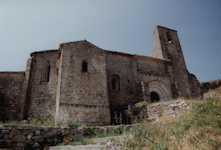

.jpg)
.jpg)




.jpg)
.jpg)
.jpg)



.jpg)
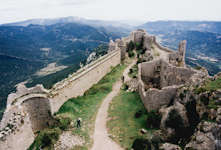
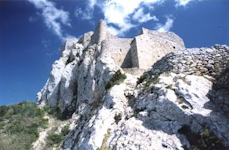
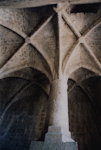
.jpg)
.jpg)
.jpg)
